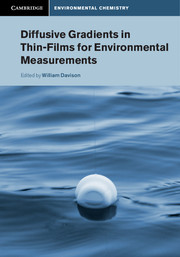Book contents
- Diffusive Gradients in Thin-Films for Environmental Measurements
- Cambridge Environmental Chemistry Series
- Diffusive Gradients in Thin-Films for Environmental Measurements
- Copyright page
- Contents
- Contributors
- Preface
- Symbols and Abbreviations
- 1 Introduction to DGT
- 2 Principles of Measurements in Simple Solutions
- 3 Diffusion Layer Properties
- 4 Binding Layer Properties
- 5 Interpreting the DGT Measurement
- 6 Applications in Natural Waters
- 7 Principles and Application in Soils and Sediments
- 8 Measurement at High Spatial Resolution
- 9 DGT and Bioavailability
- 10 Practicalities of Working with DGT
- Appendix
- Index
- References
9 - DGT and Bioavailability
Published online by Cambridge University Press: 05 September 2016
- Diffusive Gradients in Thin-Films for Environmental Measurements
- Cambridge Environmental Chemistry Series
- Diffusive Gradients in Thin-Films for Environmental Measurements
- Copyright page
- Contents
- Contributors
- Preface
- Symbols and Abbreviations
- 1 Introduction to DGT
- 2 Principles of Measurements in Simple Solutions
- 3 Diffusion Layer Properties
- 4 Binding Layer Properties
- 5 Interpreting the DGT Measurement
- 6 Applications in Natural Waters
- 7 Principles and Application in Soils and Sediments
- 8 Measurement at High Spatial Resolution
- 9 DGT and Bioavailability
- 10 Practicalities of Working with DGT
- Appendix
- Index
- References
- Type
- Chapter
- Information
- Diffusive Gradients in Thin-Films for Environmental Measurements , pp. 216 - 262Publisher: Cambridge University PressPrint publication year: 2016
References
- 7
- Cited by



